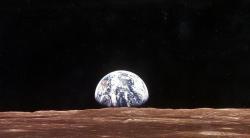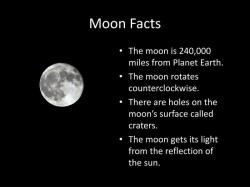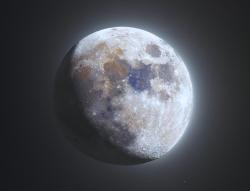What are minerals on the Moon?
The Moon is composed of a variety of minerals, and its surface features a diverse geological landscape. These minerals provide insights into the Moon's history, formation, and evolution. Here are some of the key minerals found on the Moon:
Anorthosite:
- Composition: Primarily composed of calcium-rich plagioclase feldspar.
- Location: Predominant in the lunar highlands.
- Significance: Anorthosite is a major component of the lunar crust and is often associated with the highlands.
Basalt:
- Composition: Rich in iron and titanium.
- Location: Common in lunar mare regions (dark, flat areas).
- Significance: Basalts are formed from volcanic activity and contribute to the darker areas visible from Earth.
Regolith:
- Composition: Mixture of small rock and mineral fragments, dust, and glass particles.
- Location: Covers the lunar surface.
- Significance: Regolith is the result of continuous micrometeoroid impacts on the Moon's surface.
Breccia:
- Composition: A type of rock composed of broken fragments of minerals or rocks cemented together.
- Location: Found in various lunar regions, formed from impact processes.
- Significance: Breccias provide information about the Moon's geological history and impact events.
Ilmenite:
- Composition: Iron titanium oxide mineral.
- Location: Common in lunar mare regions.
- Significance: Ilmenite is a source of titanium, and its presence influences the Moon's composition.
Orthopyroxene and Olivine:
- Composition: Iron and magnesium-rich silicate minerals.
- Location: Found in various lunar rocks.
- Significance: These minerals contribute to the overall composition of lunar basalts.
Plagioclase Feldspar:
- Composition: Aluminum-rich feldspar.
- Location: Abundant in the lunar highlands.
- Significance: Plagioclase feldspar is a major mineral in anorthosite rocks and is a key component of the lunar crust.
Glass Spherules:
- Composition: Formed from melted lunar regolith.
- Location: Scattered across the lunar surface.
- Significance: These glassy beads are created by intense heat from micrometeoroid impacts and volcanic activity.
Troilite:
- Composition: Iron sulfide mineral.
- Location: Found in lunar basalts and other rocks.
- Significance: Troilite is a common accessory mineral in lunar rocks.
Pyroxenes and Amphiboles:
- Composition: Silicate minerals.
- Location: Present in various lunar rocks.
- Significance: These minerals provide information about the conditions under which lunar rocks formed.
These are just a few examples, and the Moon's surface features a complex mixture of minerals resulting from its geological history, impact events, and volcanic activity. Studying lunar minerals helps scientists understand the Moon's formation and evolution, providing valuable insights into the broader processes that shape planetary bodies in our solar system.
Lunar mineralogy: What are minerals on the Moon?
The Moon is made up of a variety of minerals, including:
- Plagioclase: Plagioclase is the most abundant mineral on the Moon. It is a feldspar mineral that is found in both igneous and metamorphic rocks.
- Pyroxene: Pyroxene is another common mineral on the Moon. It is a silicate mineral that is found in both igneous and metamorphic rocks.
- Olivine: Olivine is a silicate mineral that is found in igneous rocks. It is less common on the Moon than plagioclase and pyroxene.
- Ilmenite: Ilmenite is an oxide mineral that is found in igneous rocks. It is the most common opaque mineral on the Moon.
- Other minerals: Other minerals that have been found on the Moon include troilite, metallic iron, and titanium dioxide.
Identifying and understanding the minerals that make up the lunar surface
Scientists use a variety of methods to identify and understand the minerals that make up the lunar surface. These methods include:
- Remote sensing: Telescopes and satellites can be used to study the composition of the lunar surface from a distance.
- Sample analysis: Lunar samples that have been returned to Earth can be analyzed using a variety of techniques, such as electron microscopy and X-ray diffraction.
- Ground-based studies: Ground-based telescopes can be used to study the Moon in greater detail. For example, scientists can use spectroscopy to study the chemical composition of the lunar surface.
Significance and implications of lunar mineral composition in scientific exploration
The mineral composition of the Moon is significant for a number of reasons. First, it can help scientists to understand the formation and evolution of the Moon. For example, the presence of plagioclase and pyroxene suggests that the Moon formed from a molten magma ocean.
Second, the mineral composition of the Moon can help scientists to identify potential resources. For example, the presence of ilmenite suggests that the Moon could be a source of titanium.
Third, the mineral composition of the Moon can help scientists to understand the potential hazards of lunar exploration. For example, the presence of troilite suggests that the Moon could be a source of dust that could damage spacecraft and equipment.
Overall, the mineral composition of the Moon is an important area of research for scientists. By understanding the minerals that make up the lunar surface, scientists can gain a better understanding of the Moon's formation and evolution, identify potential resources, and assess the risks of lunar exploration.
In addition to the above, here are some specific implications of lunar mineral composition in scientific exploration:
- The presence of water ice on the Moon could be used to support human habitation and exploration.
- The presence of rare earth elements on the Moon could be used to develop new technologies.
- The study of lunar minerals could help scientists to better understand the formation and evolution of other planets and moons in the solar system.
Overall, lunar mineralogy is a critical field of study for scientists who are interested in exploring and understanding the Moon and other planetary bodies.




